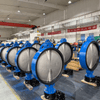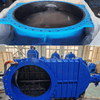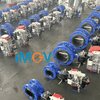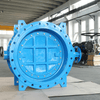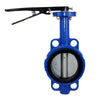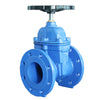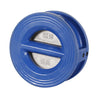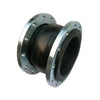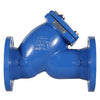Do Butterfly Valves Need Gaskets? A Complete Guide
In industrial fluid control systems, butterfly valves are widely used in various industries such as water treatment due to their compact structure, ease of operation, and cost-effectiveness. However, whether gaskets should be installed during the installation process of butterfly valves often becomes one of the key concerns for engineers. In fact, the decision to use gaskets depends on the structural type of the butterfly valve, the sealing method, and the specific operational requirements.
This article will provide a systematic overview of: which types of butterfly valves require gaskets, under what circumstances gaskets should be installed, and key considerations for selecting gaskets under different operating conditions.
What Is a Gasket?
A gasket is a sealing material used to connect two contacting surfaces, primarily serving to fill the microscopic gaps between connection surfaces and prevent the leakage of media such as water, gas, or oil. It is typically installed at the connection points of equipment such as flanges, valves, pumps, and pressure vessels.
Gaskets themselves have a certain degree of flexibility and compressibility. Under the clamping force of bolts or flanges, they can tightly adhere to the connection surfaces, providing good sealing performance even if the surfaces have irregularities, scratches, or manufacturing errors.

Which Types of Butterfly Valves Typically Require Gaskets?
1. Flanged Butterfly Valves
Do they require gaskets? Typically yes.
Flanged butterfly valves have standard flanges at both ends and are connected to the pipeline flanges using bolts during installation. Due to the clearance between the flange surfaces, leakage may occur if gaskets are not used. Therefore, flanged butterfly valves almost always require sealing gaskets during installation.

2. Wafer Butterfly Valve
Whether gaskets are required: Depends on the situation
Wafer butterfly valves are clamped between two flanges and secured with bolts. Most soft-seal wafer butterfly valves come with built-in seals (e.g., EPDM, NBR) that can achieve sealing directly without additional gaskets. However, gaskets are recommended in the following situations:
- Uneven or worn flange surfaces;
- Media is gas or volatile liquid;
- High sealing grade requirements (e.g., zero leakage);
- Metal-seal butterfly valves are used.

3. Lug Butterfly Valve
Whether a gasket is required: Similar to a wafer butterfly valve, it depends on the sealing structure.
Although lug butterfly valves have a single-sided disassembly function, their sealing principle is basically the same as that of wafer butterfly valves. If the valve has an effective sealing ring and the flange surface is in good condition, no gasket is required. Otherwise, in high-temperature or corrosive conditions, it is recommended to use a high-performance gasket.

4. Triple Eccentric Metal Sealed Butterfly Valve
Do you need a gasket? Recommended
Triple eccentric butterfly valves are commonly used in high-temperature, high-pressure, or corrosive media. Their sealing pair is metal-to-metal, which provides excellent erosion resistance but lacks elastic compensation. Installing a gasket during installation helps alleviate sealing issues caused by minor flange surface deformation.
Common Gasket Types and Applications
1.Rubber gaskets
Common materials: NBR, EPDM, FKM, etc.
Good flexibility, suitable for low-temperature, medium-pressure conditions. FKM has certain acid and alkali resistance and anti-aging properties.
2.PTFE
Excellent corrosion resistance and insulation properties, suitable for strong acids, strong alkalis, and other corrosive media.
3.Non-asbestos gaskets
Environmentally friendly material, suitable for medium-temperature, medium-pressure environments, widely used in water, oil, gas, and other conventional media.
4.Flexible graphite gaskets
Excellent thermal conductivity and corrosion resistance, low friction coefficient, suitable for high-temperature and high-pressure applications.
5.Metal composite gaskets (e.g., metal wound gaskets, covered gaskets)
Made by spirally winding metal strips and non-metallic filler materials (e.g., graphite, PTFE), with an outer layer typically reinforced by metal rings to enhance strength and stability. They offer good elasticity and sealing performance, suitable for high-temperature, high-pressure, and vibrating conditions.
Common Misconceptions About Gasket Selection for Butterfly Valves
Misconception 1: Using the same gasket specifications for wafer-type butterfly valves and flanged butterfly valves
Fact: Different flange structures require different gasket sizes and clamping methods.
Flange butterfly valves typically have a double-flange structure and are suitable for standard outer diameter (OD) gaskets.
Wafer butterfly valves are sandwiched between flanges, with a compact butterfly disc space, and are suitable for non-metallic gaskets with a slightly smaller inner diameter and flexible properties.
The bolt loading and clamping surface width also differ between the two, resulting in different gasket compression areas.
Misconception 2: All butterfly valves must use gaskets
Fact: Whether a gasket is needed depends on the valve's sealing structure.
For many wafer-type butterfly valves, the valve body already has a rubber seal, which provides some sealing effect when sandwiched between two flanges. In normal temperature and pressure conditions with clean water, no additional gasket is required.
Flange-mounted butterfly valves are often used in medium-to-high-pressure applications, where the connection surfaces are more standardised. It is generally recommended to install a gasket to enhance sealing.

In the practical application of butterfly valves, although gaskets are small in size, they play a crucial role in ensuring the sealing performance of the system. Understanding whether different butterfly valve structures require gaskets, and selecting the appropriate type and specifications of gaskets, can effectively prevent leakage risks, extend equipment lifespan, and reduce maintenance costs.
Of course, the quality of the product itself is the prerequisite for ensuring sealing performance. Union Valve specialises in providing various industrial butterfly valve products, including flanged, wafer-type, lug-type, and triple-offset butterfly valves, all manufactured using high-standard production processes. We can also provide professional valve selection based on customer operating conditions.
Union Valve always offers you stable and reliable one-stop valve solutions.

